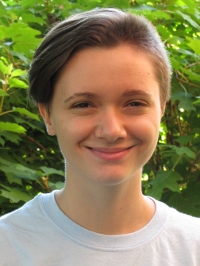2016 SRE Program Participant Profiles: MORGANNE IGOE
 |
Hometown: Lorain, OH |
Why did you apply to the SRE program?
I wanted to have a great experience doing research in the math and biology fields and the SRE program is an amazing opportunity to do that.
What is the purpose of your research?
We are trying to understand how human activities like farming and urban development affect the spread of hantavirus in rodent populations using mathematical models. Ultimately, we hope that our research will help determine how human activity affects the spread of hantavirus, which can be fatal in humans. It can hopefully be used to help people take better precautions against disease outbreaks when building cities or creating farms and therefore could help lower the number of people affected by the virus.
![]()
This program has given me great experience doing research in my field and has taught me a lot of new skills that I will use for the rest of my life. I have also met a lot of amazing people and made some great friends here as well.
![]()
– Morganne Igoe, SRE participant
Describe a typical day on the job.
In a typical day, our group meets to discuss new papers we have read and new ideas that we have had for our project and then we usually spend some time figuring out how our new information can fit into the model that we are building. Usually this involves drawing a lot of flowcharts and diagrams on white boards and trying to figure out how to make the diagrams simpler. We usually eat lunch with some of the other SRE participants and when we get stuck somewhere in our work, we will take a coffee/tea break to try to refresh our brains a little bit.
Tell us something about your field of study we would be surprised to know.
One surprising thing about biomathematics is that the people in the field come from a lot of different backgrounds including computer science, physics and political science. A lot of biomathematics research requires people from a wide range of fields, even fields that don’t fall under the STEM category.
What new experiences did you gain that have helped you today?
My experiences with collaboration and learning how to communicate with people from different fields and backgrounds has been very helpful. I also had very little experience programming or modeling and this program has definitely given me a lot of experience doing both!
What advice would you give someone who's interested in/curious about participating in the program?
I would say that you should take a look at the projects that are being offered that year and what past participants have had to say about the program, and if it looks interesting to you, to just go for it and apply. And if you decide to apply, definitely start on the application early and get your advisor or a professor to help you with your personal statement and get some good recommendation letters. Those things can be really important in showing that you are prepared to be involved in research, especially if you don’t have any prior research experience.
Would you recommend our program to others? Explain.
I would definitely recommend this program to others. This program has given me great experience doing research in my field and has taught me a lot of new skills that I will use for the rest of my life. I have also met a lot of amazing people and made some great friends here as well. It has overall just been a fantastic experience.
Related Links
Main SRE page
2016 summer program
NIMBioS
1122 Volunteer Blvd., Suite 106
University of Tennessee
Knoxville,
TN 37996-3410
PH: (865) 974-9334
FAX: (865) 974-9461
Contact NIMBioS


